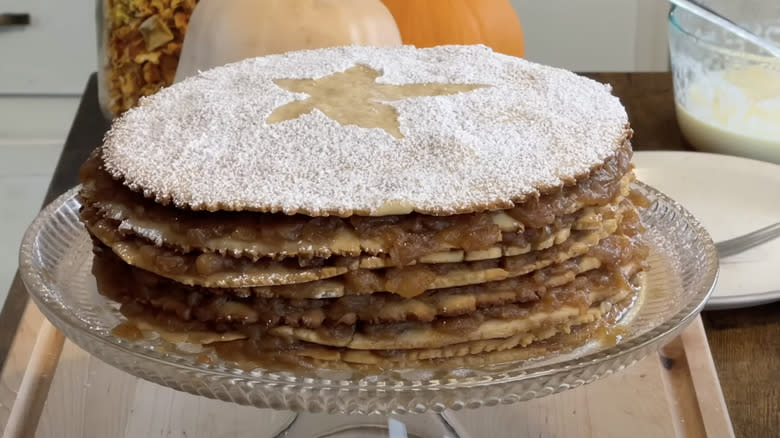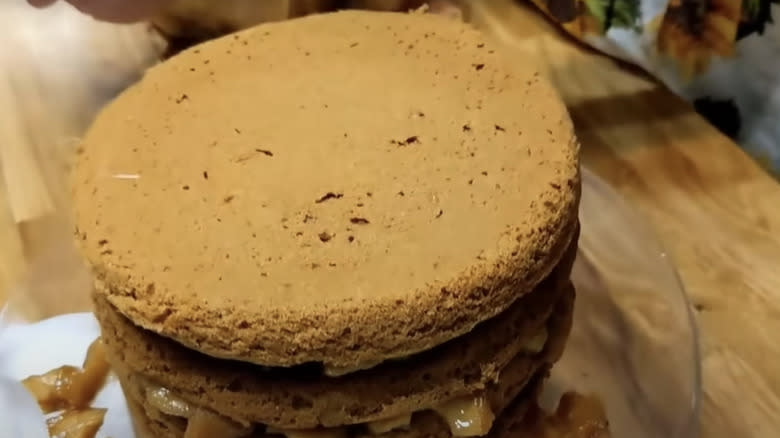The Wholesome Origin Story Behind Appalachian Apple Stack Cake

We may receive a commission on purchases made from links.
Is an Appalachian wedding really a wedding without an apple stack cake? The region is known for its desserts. Take Dolly Parton's apple pie for instance. The Southern staple is steeped in history, flavor, and folklore. While it may resemble a very tall plate of flapjacks, the apple stack case is most similar to a torte from across the pond. It's an apple-flavored cake that many families in the Appalachian mountains have their own spin on, and at the center of its origins is a claim that probably can't be true.
If oral history is to be believed, apple stack cakes were popular at weddings back in the 1800s. Wedding guests reportedly brought single layers of the cake. At the reception, all of these individual cakes would be stacked and combined with an apple filling. As a result, you're left with a cake that could feed all of the guests, and thus the Southern wedding cake, or apple stack cake as it's known was born.
However, this is likely all just a tall tale. For one, there's no actual evidence that this ever took place, even if it was a custom to bring the cake to weddings. Moreover, there's evidence to the contrary. Apple stack cakes need at least a day to fully form, which means it's unlikely that weddinggoers assembled them for consumption the day of. Still, it's a fun origin story.
Read more: Cake Hacks Every Baker Will Wish They Knew Sooner
The Truth Behind The Folklore

As for the actual origins of apple stack cakes, the dessert may have spread across the Appalachians, but it appears to have originated in Kentucky. Fans of the dessert can thank James Harrod for bringing the dessert to the region."Some food historians say that James Harrod, the colonist and farmer who founded Harrodsburg in 1774, brought the stack cake to Kentucky from his home in Pennsylvania," wrote author Mark F. Sohn in "Appalachian Home Cooking: History, Culture, and Recipes."
However, it's unknown what form this early stack cake took, as the ingredients likely weren't as readily available back then. In fact, it wouldn't be until the 1800s that the dessert's popularity ran rampant. This is also the time period for the proposed wedding reception ritual. While it's unlikely that the cake was made at the reception, perhaps some weddings in the region did have apple stack cakes in place of traditional wedding cakes. In the present day, apple stack cakes have become recipes past down from family to family. They're also popular dessert items at local bakeries in the region as well.
What Goes Into An Apple Stack Cake?

When it comes to a recipe like the apple stack cake, there's no one way to make the dessert. Since the recipe spread all across the Appalachians, families have put their own spins on the dessert. It's not uncommon to hear people discuss the apple stack cake recipe that their grandparents or another family member made for instance. However, despite differences in the recipes, apple stack cakes generally share a few common ingredients.
According to author Mark F. Sohn (via "Appalachian Home Cooking: History, Culture, and Recipes"), "The cake was popular because five of the essential ingredients — dried apples, lard, sorghum, buttermilk, and eggs — were grown and prepared on the farm, and the others — spices, flour, and baking soda — could be purchased in local markets." However, from these ingredients, recipes began to change. Some recipes call for chunkier apples while others prefer a smoother apple filling. Others choose to dust their cake with powdered sugar. You'll discover regional differences the further you look.
As one North Carolina local told The Atlanta Journal-Constitution, "Each family and community has their own idea of what an apple stack cake should look and taste like." However, what makes an apple stack cake is the rich history behind the dish.
Read the original article on Daily Meal.